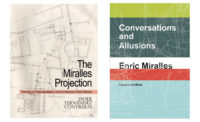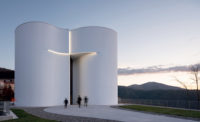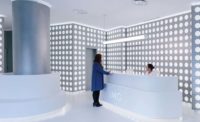Kálida Sant Pau by Miralles Tagliabue EMBT
Barcelona

Tactile facades appear solid yet porous, with latticework of concrete, brick, and ceramic tile. A pergola extends the interior’s fluidity outside.
Photo © Duccio Malagamba

Tactile facades appear solid yet porous, with latticework of concrete, brick, and ceramic tile. A pergola extends the interior’s fluidity outside.
Photo © Duccio Malagamba

The building abuts the historic Hospital de Sant Pau as well as a more recent addition to the campus.
Photo © Duccio Malagamba

The interiors blur circulation with a variety of private nooks and gathering spaces. A diverse material palette has a surprising soothing effect.
Photo © Duccio Malagamba

The interiors blur circulation with a variety of private nooks and gathering spaces. A diverse material palette has a surprising soothing effect.
Photo © Duccio Malagamba

The interiors blur circulation with a variety of private nooks and gathering spaces. A diverse material palette has a surprising soothing effect.
Photo © Duccio Malagamba

Image courtesy Miralles Tagliabue EMBT







Architects & Firms
The late Enric Miralles used to divide his architectural projects between earthworks (those that originate from moving the soil), such as Igualada Cemetery, and air works (those that start by manipulating the roofs), like his sports center in Huesca. Most of what he built in his hometown of Barcelona—Santa Caterina Market, for example, or the Gas Natural Tower, Olympic Archery Range, and Icaria Pergolas—are air works, though they are not necessarily airy or light. That is why, almost 20 years after his untimely death at 45, it feels right that a project coming out of his studio, Miralles Tagliabue EMBT—which is now led by his widow and business partner, Benedetta Tagliabue—arrives in his city as both an aerial and a topographical design. The new Kálida center at the Art Nouveau Hospital de Sant Pau aims to comfort cancer patients, the illness that killed Miralles in 2000.
A couple of years before Miralles’s death, while he and Tagliabue were working on the Scottish Parliament, Miralles met the Postmodern guru Charles Jencks. Jencks told him about his late wife, the landscape artist Maggie Keswick Jencks, who, up until her death from cancer, had been actively organizing the future Maggie’s Centres (a network of drop-in centers on hospital grounds across the UK, and in Hong Kong and Tokyo, supporting people affected by the disease). Kálida Sant Pau is the first of these facilities in Spain. It helps unify the eclectic examples of architecture on the site, creating a link, through its use of brick and decorative ceramic, with Lluís Domènech i Montaner’s Hospital de Sant Pau next door, now a Unesco World Heritage site, and the adjacent, clinical-looking hospital building that a team of architects led by Bonell & Gil-Rius finished in 2010.
Nature has a strong presence at Kálida. The 8,600-square-foot, two-story building was designed with more gardens than interior space and has a floor plan that resembles a blooming flower. The concrete-framed center appears solid yet porous, with latticework of concrete, solid brick, and ceramic tile laid in inventive repeating patterns that allow for shadow and privacy. Though its facades could not be called quiet, the building does have a camouflage factor: when seen from the hospital, the roof, finished with green and yellow tiles, reads as part of the vegetation and therefore does not compete with the adjacent historic site.
Organic and tactile, the exteriors and their sinuosity correspond to the fluidity of the interiors, which flow to form private corners as well as a common space for impromptu meetings. Kálida Sant Pau blurs servant and served spaces; circulation doubles as places to occupy. Large window compositions—with their handmade wood louvers and EMBT’s signature iroko wood carpentry—fill the interior with daylight and link it so thoroughly to the surroundings that it becomes difficult to draw a line between inside and outside. It is this ambiguity that makes the building unexpected. In a sleight of hand, the architects have also created a place that is both multifunctional and very specific. While flexible programs often sacrifice a sense of self in the name of adaptability, here spaces have a strong identity while still being able to serve a range of uses—intimate meetings, say, or larger assemblies.
The crafted brick facades reinforce the notion of genius loci, telling a story of handmade architecture and revealing the human presence in construction. A pergola of powder-coated steel with a lattice of American tulipwood extends the fluidity of the interior and the flowerlike floor plan outside. Inside, finishes coexist like a patchwork: the wood millwork, vaulted terra-cotta ceilings, and, underfoot, colorful ceramic and oak living side by side on the floors designed by Milan-based architect Patricia Urquiola. Commissioned and supported by a handful of foundations, the financing of this pavilion (which had a construction cost of $2 million) is also a work of craft.
Kálida Sant Pau is an opinionated building that speaks up. Its strength is in its showing how dialogue—between diverse materials, historic and new architecture, inside and outside, and solidity and porosity—can create a healing environment.













